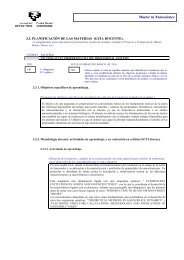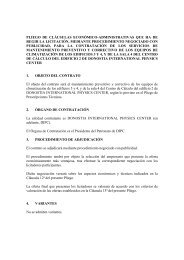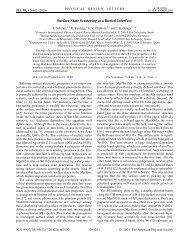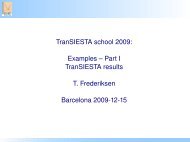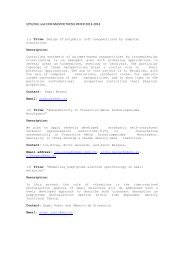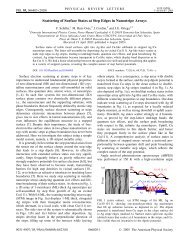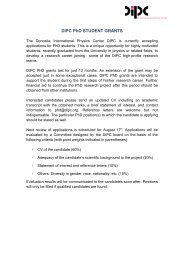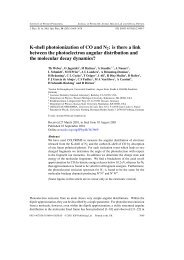SYMPOSIUM ON SURFACE SCIENCE 2011 Baqueira Beret, Lleida ...
SYMPOSIUM ON SURFACE SCIENCE 2011 Baqueira Beret, Lleida ...
SYMPOSIUM ON SURFACE SCIENCE 2011 Baqueira Beret, Lleida ...
You also want an ePaper? Increase the reach of your titles
YUMPU automatically turns print PDFs into web optimized ePapers that Google loves.
Ultrafast charge transfer at graphene surfaces<br />
Silvano Lizzit 1 , Rosanna Larciprete 2 , Paolo Lacovig 1 , Krassimir L. Kostov 3 ,<br />
and Dietrich Menzel 4<br />
1 ELETTRA, Sincrotrone Trieste S.C.p.A, 34149 Trieste, Italy<br />
2 CNR-Institute for Complex Systems, 00133 Roma, Italy<br />
3 Institute of General and Inorganic Chemistry, Bulgarian Academy of Sciences, 1113 Sofia, Bulgaria<br />
4 Physik-Dept. E20, Techn. Univ. München, 85748 Garching, Germany, and<br />
Fritz-Haber-Institut der MPG, Dept. CP, 14195 Berlin, Germany<br />
(corresponding author: dietrich.menzel@ph.tum.de)<br />
The dynamics of charge transfer (CT) between adsorbates and surfaces are important for the<br />
electronic response of surfaces and for photochemistry on surfaces [1]. The corresponding<br />
times, for instance investigated by the lifetime of excess electrons on an adsorbate, are very<br />
short – for weak to medium coupling they lie in the low femtosecond range, and for strong<br />
coupling they can be in the sub-fs range [1]. One possibility for its measurement is the socalled<br />
core hole clock (CHC) method, in which the transfer time of an excited electron<br />
(created by a resonant core hole excitation) is determined by a quantitative analysis of the<br />
core hole decay spectra which differ for the cases when the localized charge persists longer or<br />
shorter than the core hole life time [2,3]. The method makes use of the so-called Auger<br />
resonant Raman effect [4]. The rate of charge transfer depends on the overlap of the excited<br />
electron’s orbital with empty surface states of proper symmetry [5]. Qualitative connections<br />
appear to exist to the tunneling probability seen in STM and to conduction through atomic<br />
chains and molecular bridges; these have not yet been pursued in detail quantitatively. While<br />
it is likely that the main contribution to the transfer time of an initially localized excited<br />
electron comes from the transfer to the first neighbor which is normally embedded in a threedimensional<br />
conductor, it cannot be safely assumed that this is always so; the spreading of<br />
charge after transfer may also contribute to the time scale. Crudely speaking this can be<br />
expressed as imagining 3D vs. 2D final states of CT. Graphene (Gr) monolayers [6], which<br />
can be produced on metal surfaces in various degrees of coupling and geometric adaptation<br />
[7], as well as on insulators like SiC [8] (i.e. decoupled from the substrate), may offer an<br />
access to these questions. Also, the contrast seen in STM scans of Gr on metal surfaces and<br />
controversially discussed in terms of geometric and electronic contributions to tunneling [8,9]<br />
should become visible in our CT times as well.<br />
We have therefore measured CT times for resonantly core-excited Ar (2p3/2 >> 4s) atoms<br />
adsorbed on various graphene layers on metal and SiC surfaces with the well-established<br />
CHC method [1,2,5], using narrowband synchrotron light at the SuperESCA beam line of<br />
25



